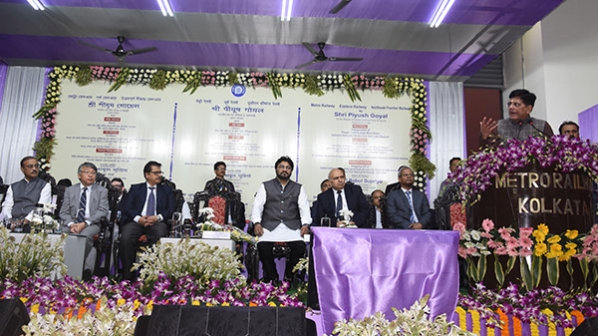The inaugural service was flagged off by minister of railways and commerce and industry, Mr Piyush Goyal, and minister of state for environment, forest and climate change, Mr Babul Supriyo, at Salt Lake Sector-V station.
Phase 1 of the 16.5km project is 5.3km long with six stations, running from a future interchange with the under-construction Line 6 at Salt Lake Sector-V to Salt Lake Stadium. The full line will connect Howrah on the west bank of the river Hooghly with Salt Lake City on its east bank, with an interchange with Line 1 and the under-construction Line 3 at Esplanade.
Construction on the line began in 2009 and Phase 1 was initially due to open in 2012. However, the project suffered numerous delays, most recently in October last year when the opening was cancelled following objections by the Commissioner of Rail Safety (CRS) on passenger safety.
During the ceremony, Goyal announced that the line is expected to be extended by one station to Phoolbagan within three to four months, with the full line set to be completed within two years. Services are operating between 08.00 and 20.00 from Monday to Saturday with 37 return services, while services on Sunday are only operating between 12.00 and 20.00 with 25 return services.
Goyal says India’s central government is determined to complete Kolkata’s ongoing metro projects within the shortest possible timeframe, and funding will be made available if land acquisition is successful.
Kolkata Metro general manager, Mr Manoj Joshi, Eastern Railway general manager, Mr Suneet Sharma, South Eastern Railway general manager, Mr Sanjay Kumar Mohanty, Kolkata Metro Rail Corporation managing director, Mr Manas Sarkar, and consul general of Japan, Mr Mesayuki Taga, also attended the opening.
Line 2 features automated fare collection ticketing gates which accept smart cards and smart tokens. The line is equipped with CBTC and has platform screen doors, luggage scanners and metal detectors at all stations. The trains feature power sockets, CCTV and ramps for emergency evacuation, while emergency announcements from the operation control centre can be transmitted directly to the trains.
For detailed information on metro projects around the world, subscribe to IRJ Pro.

